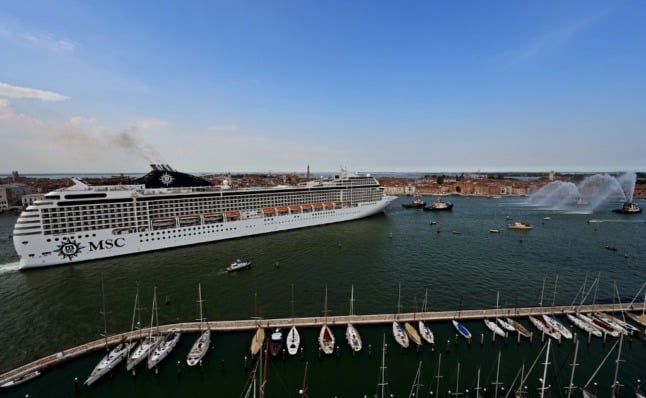With the MSC Orchestra looming over Saint Mark’s square, demonstrators in small motorboats waved banners reading “no to cruise ships”.
“Cruise ships bring a hit and run tourism that actually brings little benefit to Venice,” demonstrator Lucia Tedesco, 57, told AFP.
Concerned for the environment and the city’s cultural heritage, opponents of the ships say they cause large waves that undermine Venice’s foundations and harm the fragile ecosystem of its lagoon.
READ ALSO: ‘They’re back’: First cruise ship in 17 months arrives in Venice
But the UNESCO World Heritage site is also home to fans of the massive vessels, many organised in the “Venice at work” movement.
Around 650 people boarded the MSC Orchestra in Venice after showing a negative coronavirus test less than four days old and passing another on the spot.
They say stop-offs by tourist cruises create jobs in a city dependent on tourism – itself massively undermined by the pandemic.

None showed any sign of annoyance at the strict hygiene measures designed to prevent the intense outbreaks that hit some cruise ships at the pandemic’s height.
Just half the MSC Orchestra’s 3,000 places will be filled for its tour, taking in destinations in southern Italy, Greece and Croatia.
TRAVEL: Five lesser-known Italian summer destinations to visit this year
Italy’s government announced in March that cruise ships would no longer sail past Venice’s iconic St Mark’s Square, but instead be diverted to the city’s industrial port, thereby avoiding the city’s historic centre.
The cruise ship docked on Thursday – the first one to arrive in 17 months, signalling the return of tourism and reigniting concern over the environmental impact on the lagoon city.
However, the infrastructure is not yet ready to make this a reality.
READ ALSO: How Italy’s tourist hotspots are preparing for summer 2021
It’s not first time protesters have come out to decry the presence of cruise ships.
Environmental demonstrators have long warned that the large waves caused by the cruise ships are eroding the foundations of Venice, which along with its lagoon, are a UNESCO heritage site.
‘Our contribution to the restart of this city’
Venice’s economy had lost “around €1 billion” in the space of a year from the 800,000 fewer cruise passengers visiting, Cruise Lines International Association director Francesco Galietti told AFP – calling the Orchestra’s stop, “our contribution to the restart of this city”.
The ship’s crew took on supplies and tightened up safety protocols during their time in Venice.
As one of the world’s best-known tourist destinations, Venice’s cruise ship debate always resonates beyond Italy’s borders.
On Tuesday, a slew of international artists – from Mick Jagger to Wes Anderson and Tilda Swinton – wrote to Italian President Sergio Mattarella, Prime Minister Draghi and the mayor of Venice.
They called for a “final stop” to visits by cruise ships as well as better management of tourist flows, protection of the lagoon ecosystem and limits on property speculation to protect the city’s “physical integrity but also cultural identity”.



 Please whitelist us to continue reading.
Please whitelist us to continue reading.
Thought the idea of a UNESCO listed site was to protect it. So shameful to allow these huge ships into port.